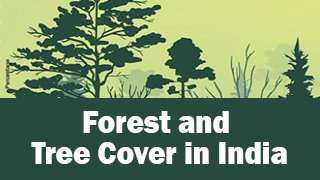Forest and Tree Cover in India
What is forest and tree cover? How are they both different?
· India is lagging behind in the targets to increase the number and quality of tree- and forest-cover plantations set in the National Mission for a Green India (GIM).
· States with significant shortfall in tree cover include Andhra Pradesh, Uttarakhand, Madhya Pradesh, and Kerela.
Tree Cover Different from Forest Cover?
· Tree cover refers to the total area of land that is covered by trees, regardless of whether or not the trees are part of a forest ecosystem.
· Forest cover, on the other hand, refers specifically to the area of land that is covered by a forest ecosystem, which is defined as an area with a tree canopy density of more than 10% and an area of more than 1 hectares.
· So, all forest cover is tree cover, but not all tree cover is forest cover.
National Mission for a Green India?
· GIM is one of the eight Missions under the National Action Plan on Climate Change.
· It aims at protecting, restoring and enhancing India’s forest cover and responding to climate change.
· The target under the Mission is 10 million hectares (Mha) on forest and non-forest lands for increasing the forest/tree cover and to improve the quality of existing forest.
· The Ministry of Environment, Forest and Climate Change supports the States/Union Territories for carrying out afforestation activities through this Centrally Sponsored Scheme.
· Improving quality of the forest
· Improving the ecosystem services of the forests
· Involvement of Gram Sabha in implementation (strengthening of local institutions)
· Generation of livelihood for local communities
· Provision of fuel-wood and fodder for local communities
· Strengthening of regulatory framework for conservation
Status of Forests in India?
· As per the India State of Forest Report-2021, forest and tree cover in the country increased by 2,261 square kilometres since the last assessment in 2019.
· India’s total forest and tree cover was 80.9 million hectares, which accounted for 24.62% of the geographical area of the country.
· The report said 17 States and Union Territories had more than 33% of their area under forest cover.
· Madhya Pradesh had the largest forest cover, followed by Arunachal Pradesh, Chhattisgarh, Odisha and Maharashtra.
· The top three States in terms of forest cover as a percentage of their total geographical area were Mizoram (84.53%), Arunachal Pradesh (79.33%), Meghalaya (76%).
Issues associated with forests in India
· According to the National Forest Policy of India, the ideal percentage of total geographical area under forest should be at least 33% to maintain ecological stability (India 24.62%).
· There is often conflict between the interests of local communities and those of commercial interests, such as pharmaceutical industries or timber industries.
· Forest disturbances caused by climate change, including insect outbreaks, invasive species due to climate led migration, wildfires, and storms, reduce forest productivity and change species distribution.
Way forward
· Technology can be utilised such as remote sensing, to monitor and track forest cover, forest fire and identify areas in need of protection.
· For safe intrastate and interstate passage of wild animals and protecting their habitat from any external influence, dedicated forest corridors can be maintained giving a message of peaceful- co existence.
· Agroforestry involves integrating trees and forest-based products into farming systems. This can help increase forest cover and also provide farmers with additional income and resources.
